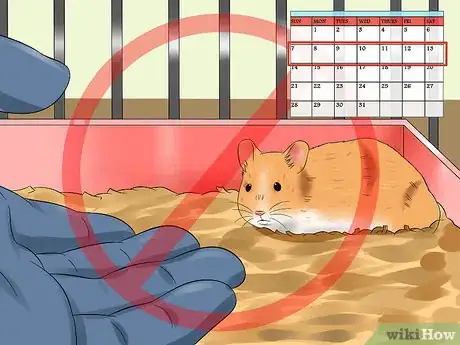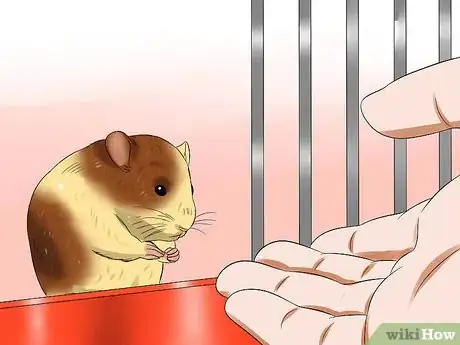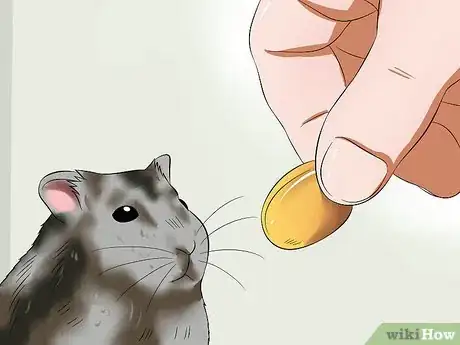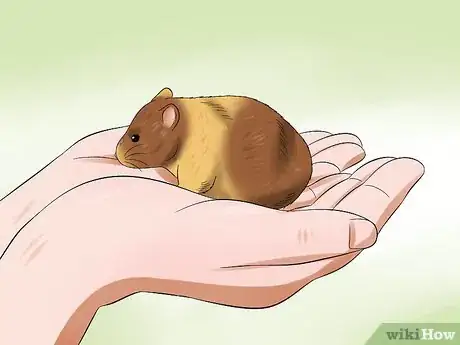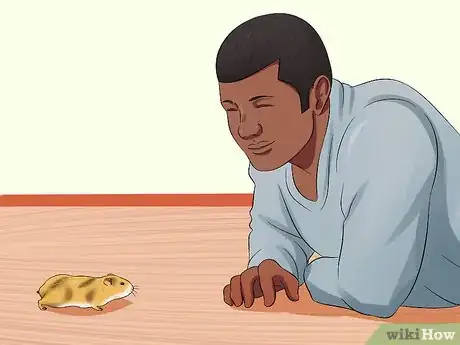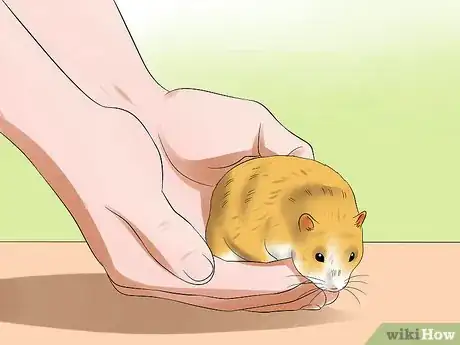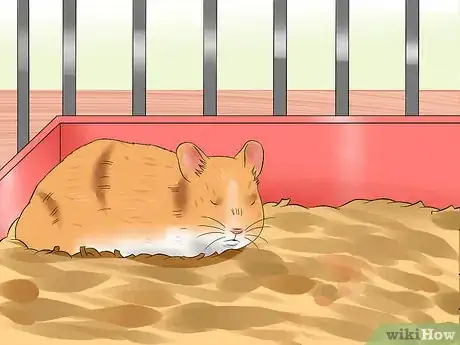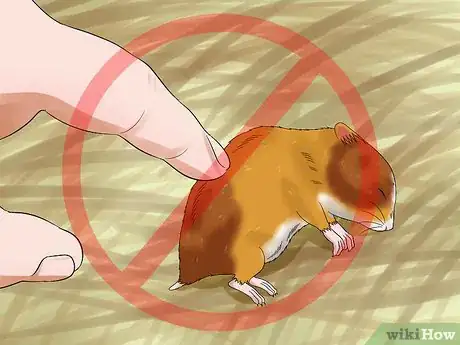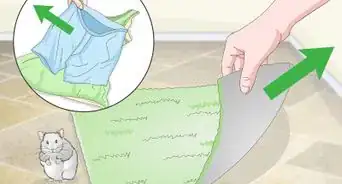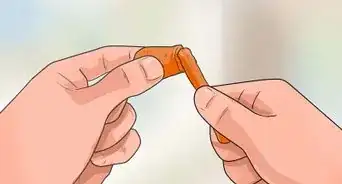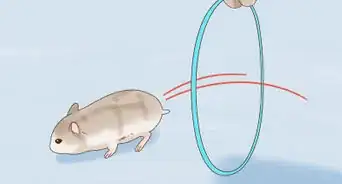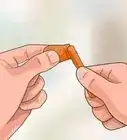This article was co-authored by Pippa Elliott, MRCVS. Dr. Elliott, BVMS, MRCVS is a veterinarian with over 30 years of experience in veterinary surgery and companion animal practice. She graduated from the University of Glasgow in 1987 with a degree in veterinary medicine and surgery. She has worked at the same animal clinic in her hometown for over 20 years.
wikiHow marks an article as reader-approved once it receives enough positive feedback. This article received 22 testimonials and 84% of readers who voted found it helpful, earning it our reader-approved status.
This article has been viewed 437,798 times.
Hamsters make great pets, but they have a habit of biting whenever they are frightened or startled. If your hamster bites, there is no reason you can't train him out of that habit. There are several things you must keep in mind when handling your hamster to avoid painful bites.
Steps
Introducing Yourself to Your Hamster
-
1Wear gloves if you have to handle your hamster before he's properly trained. There could be several situations, like if your hamster is injured, that will require you to handle your hamster prematurely. Make sure you wear gloves if you do this, because your hamster will probably try to bite you. Be as gentle as possible as well. Before your hamster is used to you, he'll probably struggle when you pick him up. Make sure to apply only light pressure or you risk injuring him.[1]
-
2Avoid picking up your hamster for about a week. Hamsters are prey animals, meaning that they're naturally used to bigger animals hunting them for food. Therefore your hamster will probably perceive you as a threat until he knows better. If you try to handle him before this period is up, he'll probably bite out of fear. For the first week you own the hamster, just let him explore his cage without touching him. In the meantime, there are exercises you can do throughout that week that will get him used to your presence and gradually make him comfortable enough to handle.[2]Advertisement
-
3Train your hamster at his own pace. Your hamster must be comfortable at each stage of training before you move on to another. Make sure he is receptive to everything before you progress, or you risk scaring him and setting back the training process.
-
4Schedule training sessions for the evening. Hamsters are nocturnal animals, and will be more active in the evening and at night.[3] Take advantage of this by waiting until the evening to start any training. Your hamster will be more awake and receptive to new experiences.
- Also stick to a regular schedule. Hold training sessions every evening. This repetition will help your hamster get used to you more quickly.
-
5Speak to your hamster softly through his cage. Hamsters have sensitive hearing and can pick up on slight sounds. Loud or harsh noises will scare them, while a soft voice will attract them. Before handling your hamster, spend some time talking in a soft voice. If your hamster learns that you produce soft sounds and not loud ones, he'll be more willing to come over to you.[4]
-
6Introduce your scent to your hamster. Like most animals, hamsters rely heavily on their sense of smell. When your hamster is used to your scent, he'll be willing to trust you.[5]
- Start by washing your hands. This will prevent you from spreading germs from your hamster, and also ensure that there are no other scents on your hand besides your own. If you smell like food, the hamster might bite because he thinks he can eat you.[6]
- Slowly insert your hand into the cage and leave it there. For the first day or two, your hamster will probably just run away. It is important to not chase after him, as this will frighten him more. Simply leave your hand motionless and wait for him to approach you. It may take a few days before your hamster is comfortable enough to approach.
- When your hamster does approach you, remain still. He's only investigating, and a sudden movement will scare him off again. He'll probably cautiously sniff you a few times. Wait until he gets very close and starts sniffing all over your hand before progressing further.
-
7Give your hamster treats. When your hamster has grown comfortable enough to approach you, start giving him treats like broccoli or cauliflower.[7] Again, always make sure you open the cage and put your hand in slowly to avoid startling your hamster. Also make sure the hamster can see the treat and that it's not hidden in your hand. Otherwise, he might think your hand is the food and bite you.[8]
- Don't try to pick him up when he takes the treat. He's still getting used to you and touching him will still probably startle him. Repeat this process for a few more days until your hamster eagerly runs over when you put your hand in the cage.
-
8Pet your hamster gently. When your hamster has grown comfortable enough to approach you, then you can start petting him. When he comes over, slowly lift your hand and pet him. Start with just a finger, and then if he is comfortable use the rest of your hand.[9]
-
9Pick your hamster up. After your hamster is comfortable with being touched, then you can try picking him up. This will probably be a week or two after you first get him. Hold out your hand and let your hamster climb in. When he does so, you can lift him up and start playing with him.[10]
-
10Keep interacting with your hamster regularly. After your hamster is trained, it will require regular interaction to keep him that way. Try to pick him up every day so he stays acclimated to your scent and is eager to interact with you. If you neglect him, you may have to train him all over again.[11]
Avoiding Bites After Your Hamster is Trained
-
1Use slow movements whenever approaching your hamster. Even after your hamster is used to you, he can still get startled by sudden movements. Hamsters have poor eyesight and usually interpret any sudden movements as a threat. To avoid bites, always approach your hamster with gradual movements to avoid scaring him.[12]
-
2Put your hamster down if he starts struggling. Hamsters bite when they're scared or stressed. If yours starts struggling or trying to get away while you're holding him, that means he's gotten uncomfortable. Pay attention to this non-verbal cue and put your hamster down. Otherwise, he may resort to biting to make sure you get the message.[13]
-
3Leave your hamster alone if he doesn't approach you. Even when your hamster is used to you, there may be times he just isn't in the mood to be handled. If your hamster doesn't approach you when you reach into the cage, leave him alone. If you grab him when he isn't in the mood, he might bite you.[14]
-
4Avoid touching your hamster if he's sleeping. Hamsters are naturally nocturnal creatures, meaning they're more active at night. That means that there's a good chance your hamster will sleep for a portion of the day. Don't disturb him if he's asleep. He'll probably interpret being suddenly awoken as an attack and naturally bite. If your hamster is asleep, let him stay that way.[15]
Expert Q&A
Did you know you can get expert answers for this article?
Unlock expert answers by supporting wikiHow
-
QuestionI gave my hamster strawberry drops and now he thinks I'm a treat and bites me. What should I do?
 Pippa Elliott, MRCVSDr. Elliott, BVMS, MRCVS is a veterinarian with over 30 years of experience in veterinary surgery and companion animal practice. She graduated from the University of Glasgow in 1987 with a degree in veterinary medicine and surgery. She has worked at the same animal clinic in her hometown for over 20 years.
Pippa Elliott, MRCVSDr. Elliott, BVMS, MRCVS is a veterinarian with over 30 years of experience in veterinary surgery and companion animal practice. She graduated from the University of Glasgow in 1987 with a degree in veterinary medicine and surgery. She has worked at the same animal clinic in her hometown for over 20 years.
Veterinarian This is a common problem caused by the scent of the food getting onto your fingers. Hamsters are notoriously short-sighted and bite your finger because they associate it with food. Avoid hand-feeding. Always wash your hands to remove the smell of food, and go back to basics with putting your hand in the cage but not near the hamster, so he gets used to your smell without thinking it's food.
This is a common problem caused by the scent of the food getting onto your fingers. Hamsters are notoriously short-sighted and bite your finger because they associate it with food. Avoid hand-feeding. Always wash your hands to remove the smell of food, and go back to basics with putting your hand in the cage but not near the hamster, so he gets used to your smell without thinking it's food.
Warnings
- Never squeeze your hamster when picking him up.⧼thumbs_response⧽
- Don't hold your hamster upside down for any length of time.⧼thumbs_response⧽
- By no means use any aggression with your hamster.⧼thumbs_response⧽
References
- ↑ http://animals.mom.me/expect-new-hamster-1040.html
- ↑ http://animals.mom.me/expect-new-hamster-1040.html
- ↑ http://www.rspca.org.uk/adviceandwelfare/pets/rodents/hamsters/behaviour
- ↑ http://animals.mom.me/ways-socialize-hamster-1092.html
- ↑ http://animals.mom.me/ways-socialize-hamster-1092.html
- ↑ http://www.smallanimalchannel.com/critter-experts/hamster/how-to-stop-a-hamster-from-biting-1406.aspx
- ↑ http://www.humanesociety.org/animals/hamsters/tips/hamster_feeding.html
- ↑ http://www.smallanimalchannel.com/critter-experts/hamster/how-to-stop-a-hamster-from-biting-1406.aspx
- ↑ http://animals.mom.me/expect-new-hamster-1040.html
- ↑ http://animals.mom.me/expect-new-hamster-1040.html
- ↑ http://animals.mom.me/expect-new-hamster-1040.html
- ↑ http://animals.mom.me/ways-socialize-hamster-1092.html
- ↑ http://www.smallanimalchannel.com/critter-experts/hamster/how-to-stop-a-hamster-from-biting-1406.aspx
- ↑ http://animals.mom.me/expect-new-hamster-1040.html
- ↑ http://animals.mom.me/expect-new-hamster-1040.html
About This Article
To train a hamster not to bite, speak to it softly, then insert your hand into the cage for it to sniff. Do this for a few days so it gets used to your scent. Next, introduce petting by gently and slowly rubbing between its ears with your index finger. Once it's comfortable with that, hold out your hand and let it climb in. At this point, your hamster is not afraid of you and shouldn't bite, but keep interacting with it regularly so it stays trained! For tips on how to avoid bites after you've trained your hamster, read on!

